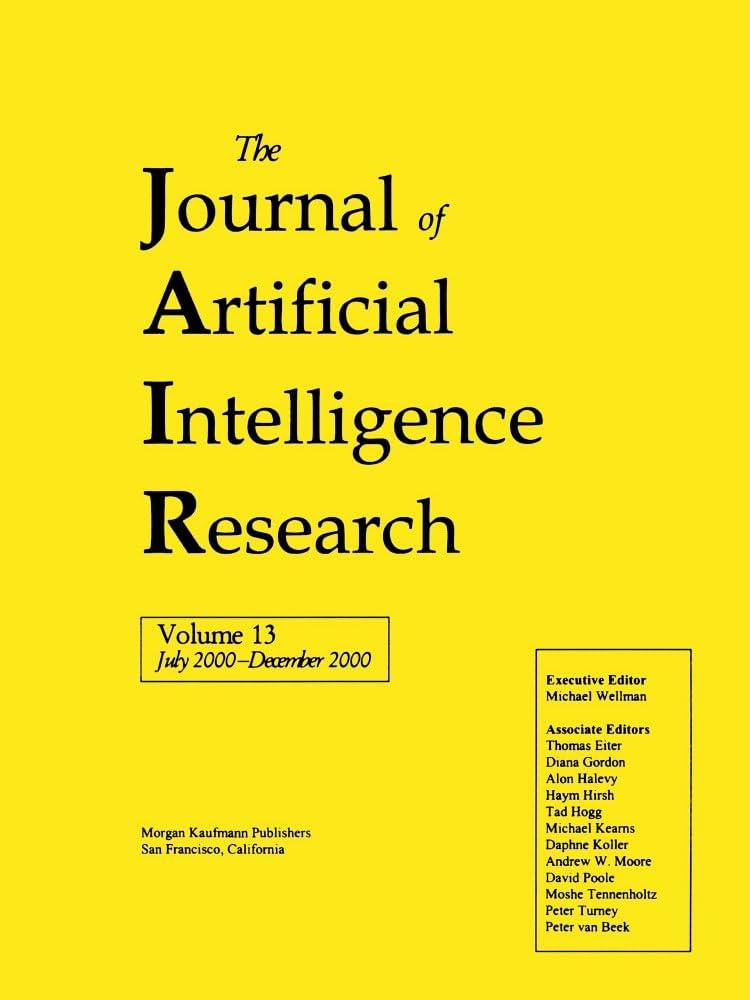Semiring Reasoning Frameworks in AI and Their Computational Complexity
IF 4
3区 计算机科学
Q2 COMPUTER SCIENCE, ARTIFICIAL INTELLIGENCE
引用次数: 0
Abstract
Many important problems in AI, among them #SAT, parameter learning and probabilistic inference go beyond the classical satisfiability problem. Here, instead of finding a solution we are interested in a quantity associated with the set of solutions, such as the number of solutions, the optimal solution or the probability that a query holds in a solution. To model such quantitative problems in a uniform manner, a number of frameworks, e.g. Algebraic Model Counting and Semiring-based Constraint Satisfaction Problems, employ what we call the semiring paradigm. In the latter the abstract algebraic structure of the semiring serves as a means of parameterizing the problem definition, thus allowing for different modes of quantitative computations by choosing different semirings. While efficiently solvable cases have been widely studied, a systematic study of the computational complexity of such problems depending on the semiring parameter is missing. In this work, we characterize the latter by NP(R), a novel generalization of NP over semiring R, and obtain NP(R)-completeness results for a selection of semiring frameworks. To obtain more tangible insights into the hardness of NP(R), we link it to well-known complexity classes from the literature. Interestingly, we manage to connect the computational hardness to properties of the semiring. Using this insight, we see that, on the one hand, NP(R) is always at least as hard as NP or ModpP depending on the semiring R and in general unlikely to be in FPSPACEpoly. On the other hand, for broad subclasses of semirings relevant in practice we can employ reductions to NP, ModpP and #P. These results show that in many cases solutions are only mildly harder to compute than functions in NP, ModpP and #P, give us new insights into how problems that involve counting on semirings can be approached, and provide a means of assessing whether an algorithm is appropriate for a given class of problems.人工智能中的半环推理框架及其计算复杂度
人工智能中的许多重要问题,如#SAT、参数学习和概率推理,都超越了经典的可满足性问题。在这里,我们感兴趣的不是寻找一个解,而是与解集相关的一个量,比如解的数量、最优解或查询在一个解中存在的概率。为了以统一的方式对这些定量问题建模,许多框架,例如代数模型计数和基于半环的约束满足问题,采用了我们所说的半环范式。在后者中,半环的抽象代数结构作为一种参数化问题定义的手段,从而允许通过选择不同的半环进行不同模式的定量计算。虽然有效可解的情况已经得到了广泛的研究,但缺乏对这类问题依赖于半环参数的计算复杂度的系统研究。在这项工作中,我们用NP(R)来描述后者,NP(R)是NP在半环R上的一种新的推广,并获得了一些半环框架的NP(R)-完备性结果。为了对NP(R)的硬度有更切实的了解,我们将其与文献中众所周知的复杂度类联系起来。有趣的是,我们设法将计算硬度与半环的性质联系起来。使用这种见解,我们看到,一方面,NP(R)总是至少与NP或ModpP一样难,这取决于半环R,并且通常不太可能在FPSPACEpoly中。另一方面,对于与实践相关的半环的广泛子类,我们可以使用NP, ModpP和#P的约简。这些结果表明,在许多情况下,解决方案只比NP, ModpP和#P中的函数更难计算,这给我们提供了关于如何处理涉及半环计数的问题的新见解,并提供了一种评估算法是否适用于给定类别问题的方法。
本文章由计算机程序翻译,如有差异,请以英文原文为准。
求助全文
约1分钟内获得全文
求助全文
来源期刊

Journal of Artificial Intelligence Research
工程技术-计算机:人工智能
CiteScore
9.60
自引率
4.00%
发文量
98
审稿时长
4 months
期刊介绍:
JAIR(ISSN 1076 - 9757) covers all areas of artificial intelligence (AI), publishing refereed research articles, survey articles, and technical notes. Established in 1993 as one of the first electronic scientific journals, JAIR is indexed by INSPEC, Science Citation Index, and MathSciNet. JAIR reviews papers within approximately three months of submission and publishes accepted articles on the internet immediately upon receiving the final versions. JAIR articles are published for free distribution on the internet by the AI Access Foundation, and for purchase in bound volumes by AAAI Press.
 求助内容:
求助内容: 应助结果提醒方式:
应助结果提醒方式:


